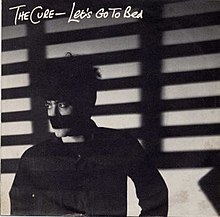Let's Go to Bed (The Cure song)
This article needs additional citations for verification. (January 2015) |
| "Let's Go to Bed" | ||||
|---|---|---|---|---|
 | ||||
| Single by The Cure | ||||
| B-side | "Just One Kiss" | |||
| Released | 15 November 1982 | |||
| Genre | ||||
| Length | 3:33 | |||
| Label | Fiction | |||
| Songwriter(s) | ||||
| Producer(s) | Chris Parry | |||
| The Cure singles chronology | ||||
| ||||
"Let's Go to Bed" is a song by English rock band the Cure, released as a stand-alone single by Fiction Records in November 1982. In the aftermath of the dark Pornography, Robert Smith returned from a month-long detox in the Lake District to write the song, the antithesis to what the Cure currently represented. It was later included on the album Japanese Whispers, which compiles the band's three singles from 1982-83 and their five B-sides.
The single was only a minor success in the UK, peaking at No. 44,[1] but became a Top 20 hit in Australasia in 1983, reaching No. 15 in Australia (for two weeks)[2] and No. 17 in New Zealand.[3]
History
The origins of "Let's Go to Bed" lie in "Temptation", one of the demos for Pornography. The song is a relatively upbeat, guitar-driven instrumental. In August 1982, soon after Simon Gallup's departure from the band, Smith demoed a vocal version of the track, entitled "Temptation Two", a psychedelic piece not far removed from the Pornography album but somewhat lighter in tone. At the end of the song, Smith sings a string of wordless syllables, nearly identical to the "doo doo doo"s of the later song. The song version was debuted on Kid Jensen's radio show on 27 November 1982, as a take which was very close to the final version that appeared as a single in the same month.[citation needed]
In an interview with Rolling Stone, Robert Smith discussed the initial reaction when playing the song to Fiction Records:
When I took “Lets Go to Bed” to Fiction and played it to them, it was like silence. They looked at me, like, “This is it. He’s really lost it.” They said, “You can’t be serious. Your fans are gonna hate it.” I understood that, but I wanted to get rid of all that. I didn’t want that side of life anymore; I wanted to do something that’s really kind of cheerful. I thought, “This isn’t going to work. No one’s ever gonna buy into this. It’s so ludicrous that I’m gonna go from goth idol to pop star in three easy lessons.”
However, the song became a success much to Smith’s surprise.
Suddenly, “Let’s Go to Bed” was turning into a big hit, on the West Coast particularly, and we had a young, predominately female, teenage audience. It went from intense, menacing, psychotic goths to people with perfect white teeth. It was a very weird transition, but I enjoyed it. I thought it was really funny. We followed it up with “The Walk” and “Love Cats,” and I just felt totally liberated.”[4]
On 15 March 1983, the song was the first broadcast for the pioneering Boston-based alternative rock radio station WFNX. When WFNX was sold and ceased broadcasting on 20 July 2012, "Let's Go to Bed" was selected as the station's final broadcast.[5]
Reception
AllMusic described the song as "antic, herky-jerky new wave pop",[6] while Pitchfork called it "bratty, funky synthpop".[7]
Music video
The song's music video was the band's first collaboration with Tim Pope,[8] who would go on to direct several more videos for the group. The video features members Robert Smith and Lol Tolhurst, who at that point were the only members of the Cure – the only instance in the band's history where the band officially had a two-person lineup. Pope’s video treatment displayed the band’s more whimsical side, something absent from the band’s early work. In his book, Tolhurst also recalls that he was dancing naked behind the screen as a shadowy silhouette.[9]
Track listing
7-inch vinyl
- "Let's Go to Bed" – 3:35
- "Just One Kiss" – 4:10
12-inch vinyl
- "Let's Go to Bed" (Extended Mix) – 7:04
- "Just One Kiss" (Extended Mix) – 7:02
US 7-inch vinyl
- "Let's Go to Bed" – 3:34
- "Boys Don't Cry" – 2:36
US 12-inch vinyl
- "Let's Go to Bed" – 7:45
- "Just One Kiss" – 7:18
- "Let's Go to Bed" (edit) – 3:35
Personnel
- Robert Smith – vocals, guitar, bass, keyboards
- Lol Tolhurst – keyboards
- Steve Goulding – drums
References
- ^ "Let's Go to Bed". Official Charts Company. Retrieved 23 October 2016.
- ^ Kent, David (1993). Australian Chart Book 1970–1992. St Ives, NSW: Australian Chart Book. ISBN 0-646-11917-6.
- ^ "The Cure – Let's Go to Bed (song)". charts.nz. Retrieved 23 October 2016.
- ^ Crandall, Bill (2004-06-18). "The Cure's Discography: Robert Smith Looks Back". Rolling Stone. Retrieved 2019-08-05.
- ^ "Listening to WFNX 1983-2012". The Boston Phoenix. Retrieved 30 June 2016.
- ^ Mason, Stewart. "Why Can't I Be You?". AllMusic. Retrieved 22 January 2013.
- ^ Abebe, Nitsuh (25 August 2006). "The Cure / Robert Smith: The Top / The Head on the Door / Kiss Me, Kiss Me, Kiss Me / Blue Sunshine". Pitchfork. Retrieved 23 October 2016.
- ^ Cured: The Tale of Two Imaginary Boys by Lol Tolhurst
- ^ "The Cure's "Let's Go to Bed"". 27 November 2017.
External links
- "Let's Go to Bed" at Discogs (list of releases)
- Template:MetroLyrics song
